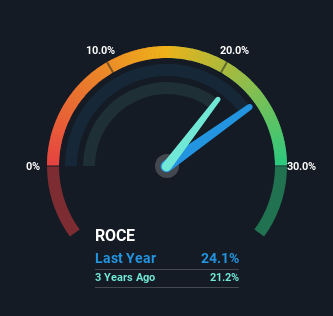Investors Shouldn't Overlook The Favourable Returns On Capital At Saksoft (NSE:SAKSOFT)
If we want to find a potential multi-bagger, often there are underlying trends that can provide clues. Firstly, we'll want to see a proven return on capital employed (ROCE) that is increasing, and secondly, an expanding base of capital employed. Basically this means that a company has profitable initiatives that it can continue to reinvest in, which is a trait of a compounding machine. That's why when we briefly looked at Saksoft's (NSE:SAKSOFT) ROCE trend, we were very happy with what we saw.
What Is Return On Capital Employed (ROCE)?
For those that aren't sure what ROCE is, it measures the amount of pre-tax profits a company can generate from the capital employed in its business. Analysts use this formula to calculate it for Saksoft:
Return on Capital Employed = Earnings Before Interest and Tax (EBIT) ÷ (Total Assets - Current Liabilities)
0.24 = ₹1.2b ÷ (₹7.0b - ₹1.8b) (Based on the trailing twelve months to December 2023).
Therefore, Saksoft has an ROCE of 24%. That's a fantastic return and not only that, it outpaces the average of 19% earned by companies in a similar industry.
Check out our latest analysis for Saksoft

While the past is not representative of the future, it can be helpful to know how a company has performed historically, which is why we have this chart above. If you're interested in investigating Saksoft's past further, check out this free graph covering Saksoft's past earnings, revenue and cash flow.
So How Is Saksoft's ROCE Trending?
We'd be pretty happy with returns on capital like Saksoft. Over the past five years, ROCE has remained relatively flat at around 24% and the business has deployed 149% more capital into its operations. Now considering ROCE is an attractive 24%, this combination is actually pretty appealing because it means the business can consistently put money to work and generate these high returns. You'll see this when looking at well operated businesses or favorable business models.
What We Can Learn From Saksoft's ROCE
In the end, the company has proven it can reinvest it's capital at high rates of returns, which you'll remember is a trait of a multi-bagger. On top of that, the stock has rewarded shareholders with a remarkable 784% return to those who've held over the last five years. So while the positive underlying trends may be accounted for by investors, we still think this stock is worth looking into further.
While Saksoft looks impressive, no company is worth an infinite price. The intrinsic value infographic for SAKSOFT helps visualize whether it is currently trading for a fair price.
High returns are a key ingredient to strong performance, so check out our free list ofstocks earning high returns on equity with solid balance sheets.
New: Manage All Your Stock Portfolios in One Place
We've created the ultimate portfolio companion for stock investors, and it's free.
• Connect an unlimited number of Portfolios and see your total in one currency
• Be alerted to new Warning Signs or Risks via email or mobile
• Track the Fair Value of your stocks
Have feedback on this article? Concerned about the content? Get in touch with us directly. Alternatively, email editorial-team (at) simplywallst.com.
This article by Simply Wall St is general in nature. We provide commentary based on historical data and analyst forecasts only using an unbiased methodology and our articles are not intended to be financial advice. It does not constitute a recommendation to buy or sell any stock, and does not take account of your objectives, or your financial situation. We aim to bring you long-term focused analysis driven by fundamental data. Note that our analysis may not factor in the latest price-sensitive company announcements or qualitative material. Simply Wall St has no position in any stocks mentioned.
About NSEI:SAKSOFT
Saksoft
An information technology company, provides digital transformation solutions in Europe, the United States, the Asia Pacific, and internationally.
Flawless balance sheet with solid track record and pays a dividend.
Market Insights
Community Narratives



